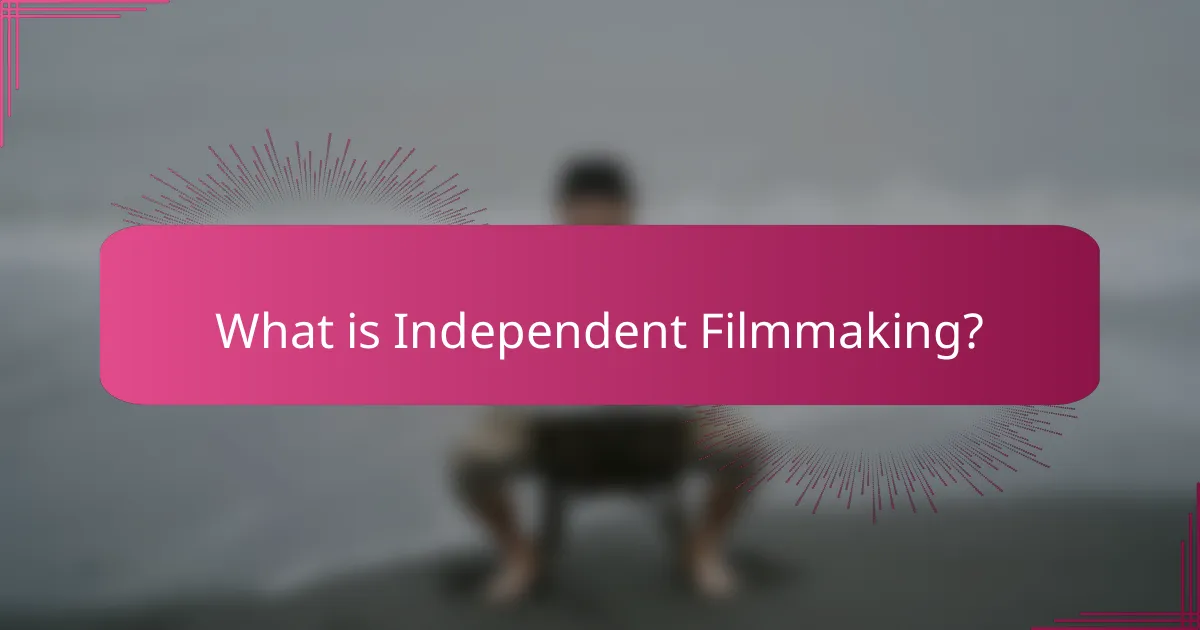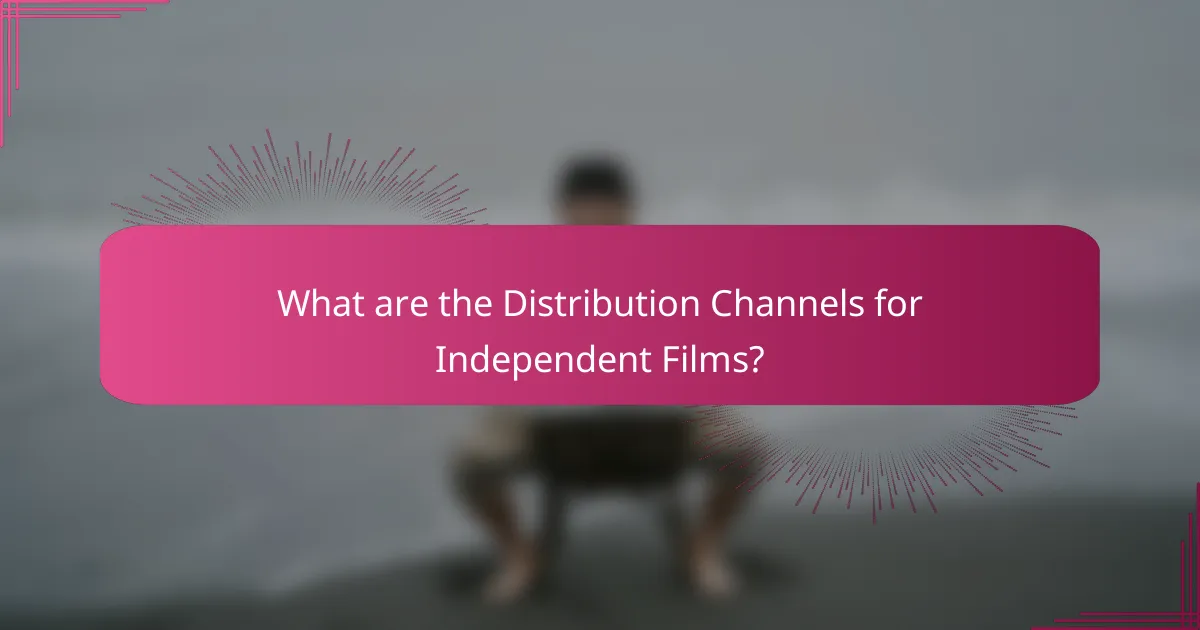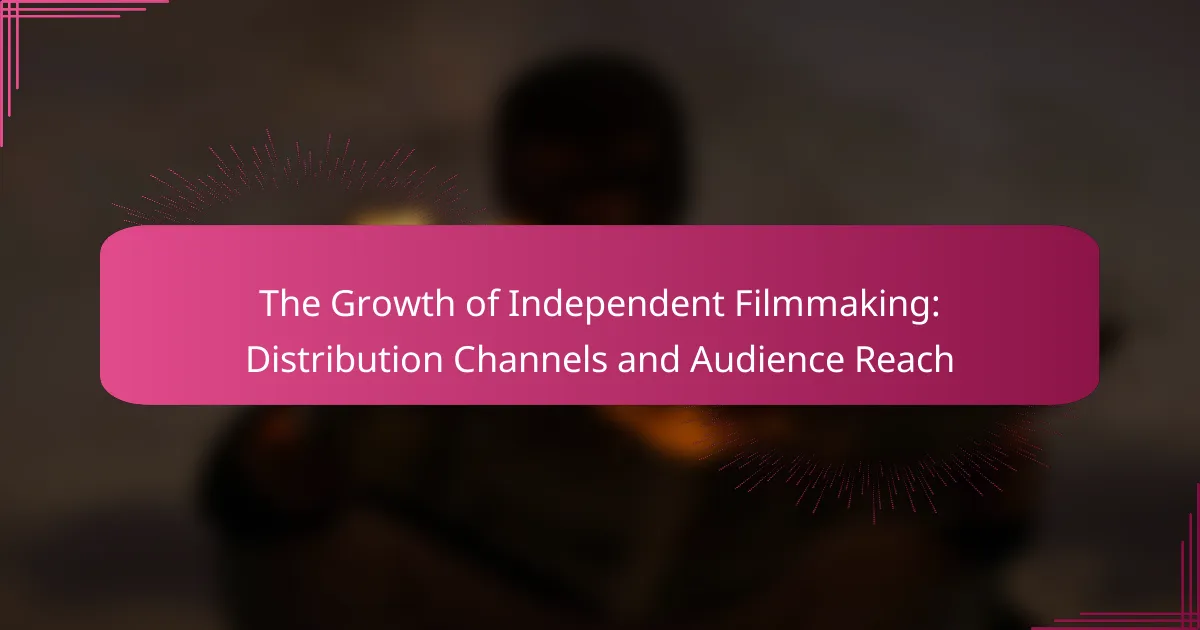Independent filmmaking refers to the creation of films outside the traditional major studio system, characterized by lower budgets and increased creative freedom. This article explores the growth of independent filmmaking, focusing on various distribution channels such as film festivals, streaming services, and online platforms that enhance audience reach. It highlights the significance of social media marketing, crowdfunding, and collaborations with influencers in promoting independent films. Additionally, the role of traditional methods like DVD sales is discussed, illustrating how independent filmmakers navigate a competitive landscape to connect with viewers and showcase unique stories.

What is Independent Filmmaking?
Independent filmmaking is the process of creating films outside the major studio system. It often involves lower budgets and greater creative control for filmmakers. Independent films typically focus on unique stories and artistic expression. They may explore niche topics that mainstream films overlook. Independent filmmakers often seek alternative distribution channels. These channels include film festivals, online platforms, and independent theaters. The rise of digital technology has facilitated the growth of independent filmmaking. It has made production and distribution more accessible to a broader range of creators.
How has independent filmmaking evolved over the years?
Independent filmmaking has evolved significantly over the years. Initially, it emerged in the early 20th century as a response to the dominance of major studios. Filmmakers sought creative freedom and unique storytelling. The rise of digital technology in the late 1990s democratized filmmaking. This allowed more individuals to create films without substantial financial backing. The internet further transformed distribution channels. Platforms like YouTube and Vimeo enabled filmmakers to reach global audiences directly. In recent years, streaming services have become vital for independent films. They provide access to diverse content and expand audience reach. The evolution reflects a shift towards greater accessibility and innovation in storytelling.
What are the key milestones in the history of independent filmmaking?
The key milestones in the history of independent filmmaking include the establishment of the American Film Institute in 1967. This organization aimed to support independent filmmakers. The rise of the Sundance Film Festival in 1981 provided a platform for independent films. The 1990s saw the success of films like “Clerks” and “The Blair Witch Project,” which showcased the potential of low-budget productions. The advent of digital technology in the 2000s revolutionized filmmaking. It made production more accessible to independent creators. The growth of streaming platforms in the 2010s expanded distribution channels for independent films. These milestones collectively contributed to the evolution and recognition of independent cinema.
How has technology influenced the growth of independent filmmaking?
Technology has significantly influenced the growth of independent filmmaking. Advances in digital cameras have made filmmaking more accessible. High-quality cameras are now available at lower prices. This allows filmmakers to produce professional content without large budgets. Editing software has also evolved, becoming more user-friendly and affordable. Filmmakers can edit their work independently, reducing reliance on traditional studios. Online distribution platforms have transformed how films reach audiences. Services like Vimeo and YouTube enable filmmakers to share their work globally. Social media allows for direct engagement with audiences, enhancing marketing efforts. These technological advancements have democratized the filmmaking process, empowering independent creators.
What are the defining characteristics of independent films?
Independent films are characterized by their low budget, creative storytelling, and artistic freedom. They often prioritize unique narratives over commercial appeal. Independent filmmakers typically retain creative control, allowing for innovative approaches. These films frequently explore unconventional themes and diverse perspectives. Independent films are usually produced outside major studio systems. They often rely on film festivals for distribution and audience reach. The Sundance Film Festival is a notable platform for independent films. Many independent films receive critical acclaim and can achieve cult status.
What differentiates independent films from mainstream films?
Independent films are characterized by their lower budgets and creative control. They typically operate outside the major studio system. This allows for more artistic freedom and unique storytelling. Mainstream films often rely on high budgets and established formulas for success. They prioritize mass appeal and box office revenue. Independent films may focus on niche markets and experimental themes. This distinction leads to varied distribution channels and audience engagement strategies. Independent films often utilize film festivals for exposure, while mainstream films dominate theaters and large marketing campaigns.
How do budget constraints impact the creative process in independent filmmaking?
Budget constraints significantly impact the creative process in independent filmmaking. Limited financial resources force filmmakers to prioritize essential elements. They often must make compromises on casting, locations, and special effects. This can lead to innovative storytelling techniques. Filmmakers may utilize unconventional methods to achieve their vision. For example, they might rely on natural lighting instead of expensive equipment. Additionally, budget constraints encourage collaboration among creative teams. Filmmakers often foster strong relationships with local talent and resources. This collaboration can enhance creativity and resourcefulness. Ultimately, budget limitations can drive unique artistic expressions in independent films.

What are the Distribution Channels for Independent Films?
Independent films are distributed through various channels. These include film festivals, which serve as platforms for exposure and networking. Streaming services like Netflix and Amazon Prime Video have become significant for independent films. Theatrical releases, although less common, still provide a traditional distribution route. Online video-on-demand platforms also offer access to wider audiences. Social media marketing plays a crucial role in promoting independent films. Additionally, DVD and Blu-ray sales remain relevant for collectors and niche markets. Each channel contributes to the visibility and success of independent films in a competitive market.
How do independent filmmakers distribute their films?
Independent filmmakers distribute their films through various channels. They often utilize film festivals to showcase their work and attract distributors. Online platforms like Vimeo and YouTube provide direct access to audiences. Independent filmmakers may also use digital distribution services such as Amazon Prime Video and iTunes. Social media plays a vital role in promoting their films and engaging with viewers. Crowdfunding platforms help finance distribution efforts and build a fan base. Additionally, filmmakers may collaborate with independent distributors for wider reach. These methods have become essential in the evolving landscape of film distribution.
What are the traditional distribution methods for independent films?
Traditional distribution methods for independent films include film festivals, theatrical releases, and home video sales. Film festivals serve as a platform for independent filmmakers to showcase their work to audiences and industry professionals. Theatrical releases allow films to be screened in cinemas, reaching broader audiences. Home video sales involve distributing films through DVDs, Blu-rays, and digital platforms. These methods have historically been essential for independent films to gain visibility and traction in a competitive market.
How have digital platforms changed the distribution landscape for independent films?
Digital platforms have significantly transformed the distribution landscape for independent films. They have enabled filmmakers to bypass traditional distribution channels. Independent films can now reach global audiences directly through streaming services. Platforms like Netflix, Amazon Prime, and Vimeo have democratized access to content. This shift has reduced the reliance on film festivals for exposure. Filmmakers can distribute their work at lower costs compared to traditional methods. Statistics show that independent films released on these platforms often see increased viewership. For example, films like “The Florida Project” gained wider recognition through digital distribution.
What role do film festivals play in distribution?
Film festivals play a crucial role in the distribution of independent films. They provide a platform for filmmakers to showcase their work to industry professionals and audiences. Festivals often attract distributors looking for new content. Successful screenings can lead to distribution deals, increasing a film’s visibility. Additionally, festivals generate media coverage that can enhance a film’s marketability. According to the Sundance Institute, many films gain distribution after premiering at their festival. This highlights the importance of festivals in connecting filmmakers with potential distributors.
How can film festivals enhance visibility for independent filmmakers?
Film festivals enhance visibility for independent filmmakers by providing a platform to showcase their work. These events attract industry professionals, potential investors, and audiences. Independent filmmakers gain exposure through screenings, panel discussions, and networking opportunities. Festivals often feature awards that can elevate a filmmaker’s profile. For instance, winning a prestigious festival award can lead to distribution deals. According to a 2020 report by the Sundance Institute, 70% of filmmakers reported increased interest from distributors after participating in festivals. This indicates that festivals play a crucial role in connecting filmmakers with broader audiences and industry stakeholders.
What are the benefits of securing distribution deals at film festivals?
Securing distribution deals at film festivals offers multiple benefits for filmmakers. First, it provides access to a wider audience. Film festivals attract industry professionals and film enthusiasts, increasing visibility. Second, distribution deals can lead to financial support. Filmmakers often receive upfront payments or advances against future earnings. Third, it enhances credibility and prestige. Winning awards or receiving recognition at festivals boosts a film’s reputation. Fourth, it opens doors for future projects. Successful distribution can attract investors for subsequent films. Finally, it allows for strategic marketing opportunities. Distribution partners often have established networks for promoting films effectively.

How do Independent Filmmakers Reach Their Audience?
Independent filmmakers reach their audience through various distribution channels and marketing strategies. They utilize social media platforms to promote their films directly to viewers. Websites and streaming services dedicated to independent films also serve as vital distribution points. Film festivals provide opportunities for exposure and audience engagement. Crowdfunding platforms allow filmmakers to connect with potential audiences and supporters. Email newsletters help maintain communication with interested viewers. Collaborations with influencers can expand their reach significantly. These methods collectively enhance visibility and audience connection for independent filmmakers.
What marketing strategies are effective for independent films?
Effective marketing strategies for independent films include social media engagement, targeted online advertising, and grassroots community outreach. Social media platforms allow filmmakers to build a fan base and share trailers. Targeted online advertising can reach specific demographics likely to enjoy the film. Grassroots outreach involves local screenings and partnerships with community organizations.
These strategies are supported by the fact that 60% of independent film audiences discover films through social media. Additionally, community events can increase local interest and attendance. Overall, these methods help independent films gain visibility and connect with potential viewers.
How can social media be leveraged to promote independent films?
Social media can be leveraged to promote independent films by creating targeted marketing campaigns. Platforms like Facebook, Instagram, and Twitter allow filmmakers to reach specific demographics. Engaging content, such as behind-the-scenes footage, can generate interest. Regular updates and interactive posts encourage audience participation. Influencer partnerships can expand reach and credibility. Hashtags can increase visibility and engagement with relevant communities. Additionally, social media advertising can drive ticket sales and streaming subscriptions. According to a 2020 study by the Independent Film Project, 70% of independent filmmakers reported social media as their primary marketing tool.
What role does audience engagement play in the success of independent films?
Audience engagement is crucial for the success of independent films. High levels of engagement can lead to increased word-of-mouth promotion. This organic marketing is vital for independent films with limited budgets. Engaged audiences are more likely to support crowdfunding efforts. They also contribute to social media buzz, enhancing visibility. Furthermore, audience feedback can shape future projects. According to a 2021 study by the Independent Film Project, films with strong audience interaction saw a 30% increase in ticket sales. Therefore, fostering audience engagement directly impacts financial success and project sustainability for independent filmmakers.
What are the challenges in reaching audiences for independent films?
Independent films face several challenges in reaching audiences. Limited marketing budgets restrict promotional activities. This often leads to reduced visibility in crowded film markets. Distribution channels for independent films are often less accessible than for mainstream films. Independent filmmakers may struggle to secure screenings in theaters. Audience awareness is also a significant challenge, as many viewers are unaware of independent offerings. Additionally, competition from major studio releases can overshadow independent films. Social media can help, but gaining traction is difficult without a substantial following. According to a 2020 study by the Independent Film & Television Alliance, 70% of independent films fail to reach their target audience effectively.
How do independent filmmakers overcome budget limitations in marketing?
Independent filmmakers overcome budget limitations in marketing by leveraging social media platforms. They utilize free or low-cost tools to reach their target audience effectively. Crowdfunding campaigns also help raise funds while generating buzz. Collaborations with influencers can expand their reach without significant costs. Filmmakers often rely on grassroots marketing strategies, such as community screenings and local events. Engaging with film festivals provides exposure and networking opportunities. Creating compelling content, like behind-the-scenes videos, attracts attention and builds a following. These strategies demonstrate that creativity can compensate for limited financial resources in marketing.
What strategies can be implemented to build a loyal audience base?
Engaging storytelling is essential to build a loyal audience base. Independent filmmakers should focus on creating relatable and compelling narratives. Consistent content delivery helps maintain audience interest. Regular updates keep the audience informed and engaged. Utilizing social media platforms can enhance visibility and interaction. Building a community around the film fosters loyalty and connection. Offering exclusive content or behind-the-scenes access can deepen audience investment. Collaborating with influencers can expand reach and credibility. These strategies have been shown to effectively cultivate a dedicated following in the independent filmmaking sector.
What are the best practices for maximizing audience reach in independent filmmaking?
Utilizing social media platforms effectively maximizes audience reach in independent filmmaking. Filmmakers should create engaging content tailored for platforms like Instagram, Facebook, and Twitter. Consistent posting increases visibility and fosters community engagement. Collaborating with influencers can expand reach to new audiences. Hosting virtual screenings or Q&A sessions creates interactive experiences. Building an email list allows direct communication with interested viewers. Participating in film festivals enhances exposure and networking opportunities. Lastly, optimizing content for search engines can attract organic traffic. These practices are supported by the growing trend of digital marketing in the film industry, where targeted strategies yield higher engagement rates.
Independent filmmaking is the primary entity of this article, which explores its growth, distribution channels, and audience engagement strategies. The article outlines the evolution of independent filmmaking, highlighting key milestones and the influence of technology on production and distribution. It discusses defining characteristics that differentiate independent films from mainstream offerings, including budget constraints and creative freedom. Additionally, the article examines various distribution channels, including film festivals and digital platforms, and effective marketing strategies that independent filmmakers can employ to reach and engage their audiences.
